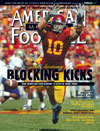AMERICAN FOOTBALL MONTHLY THE #1 RESOURCE FOR FOOTBALL COACHES
Article CategoriesAFM Magazine
|
The Strength Report: Lower Body Trainingby: Ron McKeeferyAsst. Athletic Director, Strength & Conditioning, University of South Florida © More from this issue In the last article I discussed the importance of training in both a multiple joint and single joint fashion. Multiple joint movements help to train the body to coordinate several muscle groups synergistically; protect the body from injury; and pre-fatigue muscle so that athletes donít have to add extra stress by increasing workloads. Single joint movements are used to train the weak link in sport movement and identify muscular imbalances. Both provide necessary feedback to the strength coach to improve performance and reduce the risk of injury. The body is divided up into five major areas: Neck, Hips and Legs, Mid Section, Torso and Arms. In this article we will be discussing the Hips and Legs. Hips and Legs: Our athletes will make more gains with their lower body training than any other area. I believe this beca....The full article can only be seen by subscribers. Subscribe today!
|
|
|||||||
| HOME |
MAGAZINE |
SUBSCRIBE | ONLINE COLUMNISTS | COACHING VIDEOS |
Copyright 2025, AmericanFootballMonthly.com
All Rights Reserved





